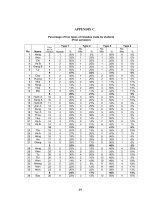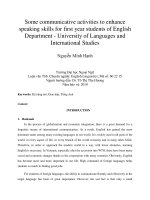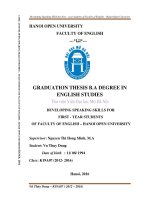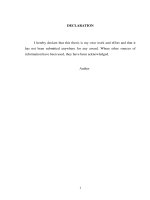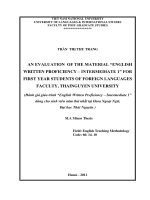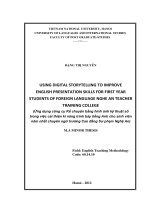Using digital storytelling to improve english presentation skills for first year students of foreign language department at nghe an teacher training college
Bạn đang xem bản rút gọn của tài liệu. Xem và tải ngay bản đầy đủ của tài liệu tại đây (905.72 KB, 54 trang )
VIETNAM NATIONAL UNIVERSITY, HANOI
UNIVERSITY OF LANGUAGES AND INTERNATIONAL STUDIES
FACULTY OF POST GRADUATE-STUDIES
-----***-----
ĐẶNG THỊ NGUYÊN
USING DIGITAL STORYTELLING TO IMPROVE
ENGLISH PRESENTATION SKILLS FOR FIRST YEAR
STUDENTS OF FOREIGN LANGUAGE NGHE AN TEACHER
TRAINING COLLEGE
(Ứng dụng công cụ Kể chuyện bằng hình ảnh kỹ thuật số
trong việc cải thiện kĩ năng trình bày tiếng Anh cho sinh viên
năm nhất chuyên ngữ trường Cao đẳng Sư phạm Nghệ An)
M.A MINOR THESIS
Field: English Teaching Methodology
Code: 60.14.10
Hanoi - 2012
i
VIETNAM NATIONAL UNIVERSITY, HANOI
UNIVERSITY OF LANGUAGES AND INTERNATIONAL STUDIES
FACULTY OF POST GRADUATE-STUDIES
-----***-----
ĐẶNG THỊ NGUYÊN
USING DIGITAL STORYTELLING TO IMPROVE
ENGLISH PRESENTATION SKILLS FOR FIRST YEAR
STUDENTS OF FOREIGN LANGUAGE NGHE AN TEACHER
TRAINING COLLEGE
(Ứng dụng công cụ Kể chuyện bằng hình ảnh kỹ thuật số
trong việc cải thiện kĩ năng trình bày tiếng Anh cho sinh viên
năm nhất chuyên ngữ trường Cao đẳng Sư phạm Nghệ An)
M.A MINOR THESIS
Field: English Teaching Methodology
Code: 60.14.10
Supervisor: Dr. Đỗ Tuấn Minh
Hanoi - 2012
ii
TABLE OF CONTENT
Page
DECLARATION
i
ACKNOWLEDGMENTS
ii
ABSTRACT
iii
TABLE OF CONTENT
vi
LIST OF ABBREVIATIONS
vii
LIST OF FIGURES AND TABLES
viii
PART I: INTRODUCTION
1
I.1. Rationale of the study ....................................................................................... 1
I.2. Objectives of the study ..................................................................................... 2
I.3. Scope of the study ............................................................................................ 2
I.4. Methods of the study ........................................................................................ 3
I.5. Significance of the study .................................................................................. 3
I.6. Overview of the study ...................................................................................... 3
PART II: DEVELOPMENT
5
CHAPTER 1: THEORITICAL BACKGROUND .............................................. 5
1.1. Oral presentation .......................................................................................... 5
1.1.1. Definition .................................................................................................... 5
1.1.2. Types of oral presentation ........................................................................... 5
1.2. Presentation skills in language learning ....................................................... 6
iv
1.2.1. Importance of presentation skills .................................................................. 7
1.2.2. Criteria for a good presentation .................................................................... 7
1.2.3. Visual aids in presentation ........................................................................... 8
1.3. ICT in language learning .............................................................................. 9
1.3.1. Definition .................................................................................................. 10
1.3.2. ICT in language learning ............................................................................ 10
1.4. Digital Storytelling ...................................................................................... 11
1.4.1. Definition .................................................................................................. 11
1.4.2. Uses of DS in education ............................................................................. 12
CHAPTER 2: RESEARCH METHODOLOGY .............................................. 15
2.1. Methodology ................................................................................................ 15
2.1.1. Research questions...................................................................................... 15
2.1.2. Participants ................................................................................................. 15
2.1.3. Conditions of teaching and learning English with ICT at Nghe An Teacher
Training College .................................................................................................. 16
2.1.4. Instruments ................................................................................................ 16
2.2. Research procedure .................................................................................... 19
CHAPTER 3: RESULTS AND DISCUSSION ................................................. 23
3.1. Results and discussions from the two mock presentations .............................. 23
3.2. Results and discussions from the questionnaire for students .......................... 27
3.3. Results and discussions from the students’ journals ...................................... 32
v
CHAPTER 4: FINDINGS AND IMPLICATIONS .......................................... 35
4.1. Findings ........................................................................................................ 35
4.2. Pedagogical implications .............................................................................. 36
PART III: CONCLUSION
38
III.1. Conclusion .................................................................................................. 38
III.2. Limitations of the study ............................................................................... 39
III.3. Suggestions for further study ....................................................................... 40
REFERENCES
41
APPENDICES
I
vi
LIST OF ABBREVIATIONS
DS: Digital Storytelling
ICT: Information and Communication Technology
EFL: English as a Foreign Language
S: student
vii
LIST OF FIGURES AND TABLES
Figure 1: Dale’s cone of experience
Figure 2: Reflective Capacity of ICT in learning process
Table 1: Establishing new learning environment
Table 2: Examiners’ assessment on the students’ presentation
Table 3: The degree of the students’ agreement in presentation with DS
Table 4: The degree of difficulties in using DS
viii
PART I: INTRODUCTION
I.1. Rationale of the study
Oral presentation is one of necessary skills in communication in general and English
language learning in particular. As Jing L. (2009, p.iii) stated, “Oral presentation is an
important skill to convey one’s ideas in communication”. Its significant role is
obviously confirmed in both theory and practice. That is why presentation skills have
been included in teaching curriculum of a variety of schools, colleges, universities and
institutions in the world. Students are required to be good at presenting after graduation
so that they can communicate successfully in society in general and in their work in
particular.
As a four-year teaching experience English teacher, the researcher finds that students at
Nghe An Teacher Training College have difficulties in presentation skills during and
after studying at the college. Via classroom observation and discussion with
colleagues, the author realizes it is a must to help students improve their presentation
skills. After having different small talks to three classes of first year English major
students, the researcher find out some reasons why they are weak at presentation skills,
namely shyness, lack of confidence, lack of vocabulary.
After studying different sources, the author decide to choose Digital Storytelling to
support students’ presentations and would like to examine its effects on their
presentations.
Digital Storytelling is an Information Communication Technology (ICT) tool which is
widely used in education. Obviously, ICT has been widely applied at many schools,
colleges and universities in the world. Similarly, the Ministry of Education and
Training of Vietnam (MOET) has given different policies with the purpose of applying
1
ICT in teaching and learning. As requested by MOET, all teaching institutions have to
integrate ICT in teaching and learning, especially teachers have to “reasonably use ICT
in every subject, avoid ICT abuse” (MOET, 2008, p.3).
In the line with ICT guidelines of the MOET, lecturers and students at Nghe An
Teacher Training College are encouraged to use ICT in teaching and learning
effectively. Several workshops and teaching competition are organized at the college.
The above situation urges the researcher to conduct the study “Using Digital Photo
Storytelling to improve English presentation skills for first year students of Foreign
Language Department at Nghe An Teacher Training College”.
I.2. The objectives of the study
The study examines to what extent DS improves the presentation skills of first year
EFL students at Nghe An Teacher Training College, Vietnam.
The objectives of the study are:
- Examine how DS improve the presentation skills of students.
- Investigate students’ opinions about using DS in presenting.
To fulfill the above objectives, the research questions are:
1- To what extent does DS help improve presentation skills of 1st year EFL
students at Nghe An Teacher Training College?
2- What are students’ opinions about using DS in presenting?
I.3. Scope of the study
Due to the limited time and school schedule, the target group of study is fourteen first
year EFL students at Nghe An Teacher Training College.
2
I.4. Methods of the study
The study employs action research. Action research is proved to be an effective
approach because the study aims at improving students’ presentations within a certain
context.
Two mock presentations, journals of students and questionnaire are conducted.
I.5. Significance of the study
The research hopes to be valuable to both teachers and students who are interested in
applying ICT in active teaching and learning. Firstly, this study contributes experiences
in active teaching and learning process in the college. Secondly, it provides a particular
finding to indicate whether the use of ICT, especially DS improves foreign language
learning. Last but not least, it is a good opportunity for the researcher to gain
knowledge in conducting research.
I.6. Overview of the study
The study is divided into three parts, which are presented as follows.
Part I is the introduction, which states the rationale, aims and objectives, scope,
methods, significance and the overview of the study.
Part II is the development of the study which consists of four chapters.
Chapter 1 is theoretical background, which presents necessary literature
related to the study.
Chapter 2 is research methodology, which describes how the study was
carried out at Nghe An Teacher Training College.
Chapter 3 is data analysis and discussion.
3
Chapter 4 is findings and some suggestions for better application of digital
storytelling in education.
Part III is the conclusion which summarizes the study and gives some
recommendations for further study.
4
PART II: DEVELOPMENT
CHAPTER 1: THEORITICAL BACKGROUND
This chapter is concerned with some of the most important issues relating to the
application of DS in students’ presentation, namely oral presentation, presentation
skills in language learning, the role of ICT in language learning and DS – notion and
uses.
1.1. Oral presentation
1.1.1. Definition
Presentation is the act of showing something or of giving something to somebody
(Oxford Advanced Learner’s Dictionary, 2005, p.1190).
According to Scott (cited in Jing L. 2009, p.4-5), “oral presentation tends to present
ideas and information in an interactive way”. He also said that oral presentation can be
“a particularly effective way to communicate your concept and complex ideas because
the presenter can use overhead projector and other visual aid and the audience can
ask for further clarification.” In other words, Scott addressed the importance of oral
presentation in communication.
Generally speaking, oral presentation is a way to express the presenter’s ideas to
formally communicate with other people.
1.1.2. Types of oral presentation
According to Whatley R. P., there are five types of oral presentation namely
informative, instructional, arousing, persuasive and decision-making.
5
Informative presentation: the purpose of the presenter is to give
information to the audience about things or facts.
Instructional presentation: it might last longer than informative
presentation because it addresses to specific directions or orders. New
knowledge or a new skill is presented in this type of presentation.
Arousing presentation: as its name, this type of presentation is to arouse
the audience’s interests or feelings to solve an issue or a problem which
the presenter mentions.
Persuasive presentation: the presenter presents an issue with evidence
and sufficient logic to convince the audience.
Decision-making presentation: the audience is persuaded to take an
action in the presentation. They will know what and how to carry out the
presenter’s requests.
It can be seen clearly from the above that Whatley categorized oral presentation based
on the purpose of the presenter. In spite of basing on the same criterion, oral
presentation has been categorized into two types on the website of Hampden-Sydney
College namely informative and persuasive presentation.
Although oral presentation has been categorized differently, each type of oral
presentation has its own specific purpose and requires a clear, structured organization
to deliver the message to the listeners.
1.2. Presentation skills in language learning
6
Achieving different skills to work effectively and live peacefully is a must in society. It
is necessary for people to absorb a variety of skills such as communication skills, selfmanagement skills, and critical thinking skills and so on.
In this part, the author would like to clarify the notion of presentation skills, the
importance of presentation skills in classroom. Next, criteria for a good presentation
have been adapted to suit the college’s curriculum. Although different criteria have
been given, visual aids have been focused on to see how important it is in a
presentation.
1.2.1. Importance of presentation skills
At universities, institutions or colleges, it is obvious that EFL students must have
excellent communication after graduation. In other words, their written, oral and
listening skills must be good enough to be able to work in society. Thus, it is necessary
to be good at presentation skills which help students to deliver positive learning
experiences.
Regarding the importance of presentation skills in the classroom, Alshare and Hindi’s
study (2004) shows that “students are required to present in two classes per semester
for an average of ten minutes” and “students and instructors agreed that critical
objectives of presentations were to improve communication skills and to train students
to talk to a group of people.”
To sum up, presentation skills play a significant role in teaching and learning a foreign
language. It not only helps students know how to read, to write and to listen but also
know how to communicate with English speaking people.
1.2.2. Criteria for a good presentation
There are different views on “What is a good presentation?” As Powell (2002) stated:
7
Many things contribute to the success of a presentation - new and unusual
content, a clear structure, a good sense of timing, imaginative use of visual
aids, the ability to make people laugh . . . and think. But above and beyond all
of these is enthusiasm. (p.6)
In other words, according to Powell’s view, enthusiasm is the most important element
of a successful presentation. It can be seen via languages and some techniques such as
voice and delivery, content language, rhetorical technique and question handling.
Meanwhile, D’Arcy (1998) do not emphasize on any criteria to evaluate a presentation.
Five criteria are given in his set of evaluation that is commonly used: organization and
development of content, delivery, visuals, voice and comments.
Although Powell (2002) and D’Arcy (1998) use different terms for the evaluation
criteria, both of them consider content, delivery and voice to be the important criteria
of presentation evaluation. Powell, however, does not include visual aids as a criterion
to evaluation a presentation. Differently, it is one of five criteria in D’Arcy’s set of
evaluation. Similar to D’Arcy’s point of view, the College of Adult and Professional
Programs (2011) rate visual aids 15% out of 100% of a successful presentation.
In this study, the presentation evaluation criteria used to evaluate the students’
presentation are mainly adapted from the criteria designed by the College of Adult and
Professional Programs and Hong Kong Examination and Assessment Authority.
1.2.3. Visual aids in presentation
In terms of definition of visual aids, it can be understood as “a variety of forms from
physical objects, photographs and maps to slides, overheads and computer generated
presentations” (Stoner, 2009, p.1).
8
It is obvious that visual aids play an important role in presentation. They can make a
presentation more interesting and effective. Moreover, research showed that people can
generally remember deeply when they use more senses at the same time. It has been
summarized as follows:
(from />As stated by Powell (2002, p.20), “visuals are important in any professional
presentation”, especially they are more important when people present in a foreign
language because “visual information is highly memorable and reduces the amount of
talking”.
In most of presentation evaluation criteria, visual aids are included and assessed as an
important criterion of a good presentation.
1.3. ICT in language learning
9
1.3.1. Definition
According to Education Testing Service, Information and Communication Technology
(ICT) refers to “the set of activities technologies that fall into the union and
communication technologies.” In other words, ICT is the connection between IT and
communication technologies. In fact, ICT and IT can be used interchangeably.
ICT includes “all forms of computer and communications equipment and software
used to create, design, store, transmit, interpret and manipulate information in its
various formats.” (The University of Queensland, />1.3.2. ICT in language learning
With the application of ICT, students have an opportunity to experience with new
environments in which they discover and develop themselves.
As summarized by International Society for Technology in Education (2000, cited in
Thomas, 2000, p.7), the perspectives of education might be changed by ICT as follows:
Table 1. Establishing new learning environment (International Society for Technology
in Education, 2000)
Traditional environments
New environments
Teacher-centered instruction
Learner-centered
Single sense stimulation
Multisensory stimulation
Singpath progression
Multipath progression
Single media
Multimedia
Isolated work
Collaborative work
Information delivery
Information exchange
Passive learning
Active/ exploratory/ inquiry-based
10
learning
Factual/ literal thinking
Critical thinking, informed decisionmaking
Reactive response
Proactive/ planned action
Isolated, artificial context
Authentic, real world
Learners take part in classroom activities more actively with the support of ICT. The
effects of ICT has been reflected by Montieth M. (2004, p.23) as below:
Teachers
ICT allows objectification of learning
situation and process, can encourage
discussion on procedures and results
Teachers
Pupils/ students
Figure 2: Reflective Capacity of ICT in learning process.
As can be seen from Figure 2, ICT has an impact on the interaction between teachers
and teachers, between teachers and students.
1.4. Digital storytelling
1.4.1. Definition
Storytelling, as its name, is an action of telling a story about different issues of daily
life. This notion is familiar to most people in the world. However, thanks to the modern
technical development, stories have been designed with the support of computer and
shared to everyone in the world via the Internet, i.e. digital storytelling.
Actually, there are a lot of definitions of DS. Ohler (2008) (cited in Yuksel et al., 2010)
describes DS as a creative process in which a traditional story is combined with
personal digital technology, such as a computer, video camera, and sound recorder.
11
Having the same point of view with Ohler, Meadows (2003) (cited in Yuksel et al.,
2010) stated that DS is a personal story which makes use of digital cameras,
computers, and non-linear authoring tools to form short, multimedia narratives.
According to Rule (cited by Belgium Project – ICT for active teaching and learning –
2005, p.56), DS is “the modern expression of the ancient art of storytelling. Digital
stories derive their power by weaving images, music, narrative and voice together,
thereby giving deep dimension and vivid color to characters, situations, experiences,
and insights.”
From the above points of view, it can be defined that DS is a tool used to design stories
with the aids of digital technology. DS can be created with productivity software such
as MS PowerPoint or similar presentation tools as well as with more specialized
software solutions. In this study, the students are instructed to use the software Photo
Story 3 to design DS for their presentation.
1.4.2. Uses of DS in education
DS has attracted many educators, college instructors, college students, school teachers,
researchers as well as instructional technologists. Therefore, a great number of
researches have been carried out to explore the uses of DS in the area of education.
Yuksel P. et al.’s study (2010) about the educational uses of DS from twenty-six
countries in the world shows that “DS supports student understanding of subject area
knowledge, overall academic performance, as well as writing, technical, presentation,
and research skills.” The research also indicates that the use of DS in classroom by
teachers affected positively to students’ higher order of thinking, social, language,
reflection and artistic skills. Especially, the result of the survey shows that DS “allows
students to construct their own understanding or experience in a content area,
facilitates collaborative activities in which students work together in a small group and
12
promotes in-class discussion”. In addition, findings of the research suggest that
teachers can use DS in multiple subject areas.
Meanwhile, Signes’s paper (2008) summarizes some uses of DS, namely providing
instruction in different literacy skills, elaborating an ePortfolio, integrating the old and
the new, developing new teaching and learning material, increasing learner’s
motivation and deep learning and developing self-assessment and team-work. In term
of literacy skills, it is noticeable that “DS is associated with the development of
multiple skills”, and Robin (cited in Signes, 2008, p.24) summarized those skills as
follows:
Research skills: Documenting the story, finding and analyzing pertinent
information;
Writing skills: Formulating a point of view and developing a script;
Organization skills: managing the scope of the project, the materials used
and the time it takes to complete the task;
Technology skills: learning to use a variety of tools, such as digital
cameras, scanners. Microphones and multimedia authoring software;
Presentation skills: deciding how to best present the story to an audience;
Interview skills: finding sources to interview and determining individual
roles for group members;
Problem-Solving skills: Learning to make decision and overcome
obstacles at all stages of the project, from inception to completion; and
Assessment skills: gaining expertise critiquing their own and other’s
work.
Thus, it can be seen clearly that DS has significant uses in education in which teachers
can exploit it or instruct their students to discover it themselves.
13
In smaller scale, Afrilyasanti and Basthomi (2011) examine the uses of DS in teaching
EFL speaking. The study indicates that “the activities involved in the DS production
potentially encourage students to actively speak up, improve their vocabulary, and
train their pronunciation and fluency” (Afrilyasanti and Basthomi, 2011, p.90). In
other words, DS motivate students to take part in speaking activities and actively
contributed the lesson.
Via observation and small talks to students, the researcher find that most of students
are nervous and shy in presenting even though they are provided language items of
presentation in class and practise presenting with their friends. In addition, the way
they organize their presentation is difficult to follow. Thus, it is necessary to help
students to overcome difficulties in presentation.
According to the Teaching Center of Washington University in St. Louis (2009),
teachers can solve the above problem by using one, two or all of the following
methods. First, teachers can help students to improve their verbal and non-verbal
communication. Second, they can make them be aware of the effective use of the
chalkboard and visual aids and instruct them to use those ones effectively. Finally,
effective and meaningful content will be emphasized and instructed to present by
teachers.
For the first and the third solutions, students are trained and practise in class. In terms
of chalkboard and visual aids, although teachers at Nghe An Training College explain
the role of them and put it to be one of the criteria for presentation evaluation, there are
few students exploiting the uses of those ones. Therefore, the researcher decides to
provide a tool which can support them in the process of presentation, i.e digital
storytelling.
14
CHAPTER 2: RESEARCH METHODOLOGY
This chapter gives a thorough description of how the research was carried out. The first
part is about the background of the participants and the description of the research
context. The next part concerns the research instruments used in the study. The
research procedure and research framework are in the last part.
2.1. Methodology
2.1.1. Research questions
The study aims at answering the following questions:
1- To what extent does DS help improve presentation skills of 1st year EFL
students at Nghe An Teacher Training College?
2- What are students’ opinions about using DS in presenting?
2.1.2. Participants
Fourteen first year EFL students are female, aged from 19-20. According to the
entrance exam, the students are at pre-intermediate English level. They lack confident
at presenting and communicating with each other. They are motivated in using ICT but
limit exposure to ICT.
Ten of the students had laptops and regularly used in class to download documents and
keep in touch with their friends via e-mails, facebook, yahoo messenger and blog.
It is noticeable that the researcher is responsible for speaking lessons in the class of the
participants. This class consists of twenty three students and actually all of them have a
desire to participate in the research programme. However, the researcher would like to
15
focus on a small number of students and examiner the effects of DS before applying
widely. That is why only fourteen of students are chosen to take part in the research.
2.1.3. Conditions of teaching and learning English with ICT at Nghe An Teacher
Training College
In the line with ICT guidelines of the MOET, lecturers and students at Nghe An
Teacher Training College have been encouraged to use ICT in teaching and learning
effectively. That is also the reason why the college has been equipped with wi-fi
system, computer rooms and audiovisual rooms. Teachers can use audiovisual rooms
provided that they register to the administrative office in advance.
In an audiovisual room, there were some facilities as below:
- A computer with useful software and programs such as Microsoft Office
(Word, PowerPoint, ...), Window Media Player, Inspiration, etc.
- Two speakers.
- A projector and a screen connected with the computer.
Most lecturers at Nghe An Teacher Training College have opportunities to participate
in different professional development programs of the Ministry of Education and
Training and of different organizations. The programs focus on ICT basic skills, ICT
for active teaching and learning. Most EFL teaching lecturers use ICT quite often.
Students at the college also have to learn ICT as a compulsory subject in the
curriculum. They have opportunities to take part in a variety of workshops and ICT
lessons organized by different organizations.
2.1.4. Instruments
16
The study has been conducted to examine the effects of Digital Photo Storytelling in
improving presentation skills of the first year students of Foreign Language
Department at Nghe An Teacher Training College. The author decided to use a variety
of research instruments: two mock presentations, students’ journals and questionnaire.
2.1.4.1. Two mock presentations
With the purpose of examining students’ presentation before and after using DS, the
participants were requested to present their own topics individually. These topics were
different from those in their course books or assignments which were given by their
teachers. The researcher listed ten suggested topics for students and they could choose
one of them or register another one which was not in their course books or
assignments. In the end, they chose the following topics for their presentations:
environment, my mother, my father, climate change, students and love, smoking, a trip
to Nha Trang, my family and media.
To be objective in assessing students’ presentations, two examiners were invited to the
presentation tests. They are lecturers of Nghe An Teacher Training College and have
twelve years of teaching English. In addition, they had never taught the participants
before.
Especially, students’ presentations were captured by a camera. Thus, the researcher
could base on not only the examiners’ assessment but also the videos to analyze the
process of presentation of students more specifically.
The first mock presentation was made after one week preparation and also after one
week starting studying at the college. The second mock presentation was taken after
two-month study at the college and students also had one week to prepare for their
presentations.
17
2.1.4.2. Students’ journals
It is a fact that students’ journal is a form of data collection which helps teachers
gain insights into the language learning process. Journaling is recommended as a way
to keep track of not only observations but also feelings associated with the action
research process. Thus, in order to collect additional qualitative data, journals were
adopted to investigate students’ impressions and feelings during or right after the
activities were carried out.
Journal writing have certain advantages, one of the most important of which is that it
“provides access to the hidden affective variables that greatly influence the way
teachers teach and students learn” (Brock, Yu and Wong, 1992, cited in Wallace, 1998,
p.63). These authors also presented the following advantages of journals:
1. They provide an effective means of variables that are important to individual
teachers and learners.
2. They serve as a means of generating questions and hypotheses about teaching
and learning processes.
3. They enhance awareness about the way a teacher teaches and a student learns.
4. They are an excellent tool for reflection.
5. They are simple to conduct.
6. They provide a first-hand account of teaching and learning experiences.
7. They are the most natural form of classroom research in that no formal
correlations are tested and no outside observer enters the classroom dynamic.
8. They provide an on-going record of classroom events and teacher and learner
reflections.
9. They enable the researcher to relate classroom events and examine trends
emerging from the diaries.
10. They promote the development of reflective teaching.
18
